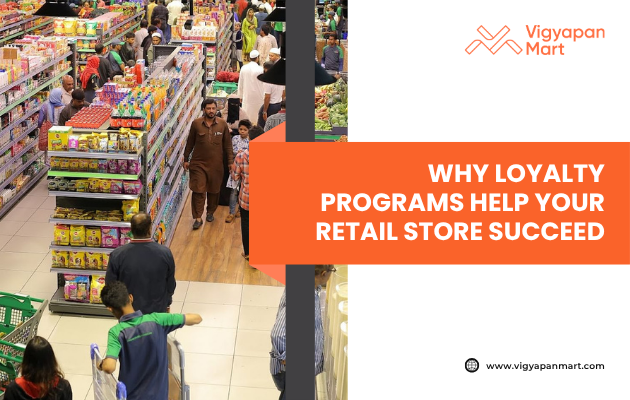Why Loyalty Programs Help Your Retail Store Succeed?

What Is a Loyalty Program?
A loyalty program is a plan that rewards customers for shopping with a store. It can be as simple as a card that gives you points for every purchase or an app that gives you special deals. The main goal is to make customers want to come back again and again.
Why Do Loyalty Programs Matter for Retail Stores?
Loyalty programs help stores in many ways:
- They keep customers coming back. People like to feel special and rewarded. When a store gives them something extra, they are more likely to return.
- They help stores make more money. Customers who join loyalty programs usually spend more money at that store than those who do not.
- They build strong relationships. When customers feel valued, they trust the store more and are more likely to tell their friends about it.
- They help stores compete. With so many shops to choose from, a good loyalty program can make your store stand out.
What Do the Numbers Say?
Here are some facts and figures that show why loyalty programs are a smart choice for retail stores:
- Nearly 70% of brands say their loyalty programs help increase customer engagement.
- 58% of brands see more repeat purchases thanks to loyalty programs.
- Loyalty program members spend 3.1 times more than non-members.
- 85% of customers say they are more likely to keep shopping with brands that have loyalty programs. Almost 64% of loyalty program members spend more to get rewards.
- Brands with loyalty programs see 12-18% more revenue growth per year.
- Over 83% of customers say loyalty programs influence their decision to buy again.
How Do Loyalty Programs Work?
Loyalty programs can be simple or complex. Here are some common types:
- Points-based programs: Customers earn points for every purchase. Points can be exchanged for discounts or free items.
- Tiered programs: Customers reach higher levels by shopping more. Each level gives better rewards.
- Paid membership programs: Customers pay a fee to join and get special deals or early access to sales.
- Gamification: Stores use games or challenges to make shopping fun and engaging.
Why Is Personalization Important?
Customers like to feel special. When a store knows what they like and offers rewards that match their interests, they are more likely to stay loyal.
- 58% of businesses invest in personalization. They use data to offer rewards that fit each customer’s needs.
- Over 40% of loyalty programs see higher redemption rates with personalized rewards. Customers use their rewards more often when they feel the offers are just for them.
- Personalized rewards make customers feel valued and understood. This builds trust and keeps them coming back.
The Power of Experience-Based Rewards
Some stores offer more than just points or discounts. They give customers special experiences, like early access to new products, VIP events, or exclusive services.
- 34% of brands focus on experience-based rewards. These rewards make shopping more exciting and memorable.
- Experience-based rewards create strong emotional connections. Customers remember these moments and are more likely to stay loyal.
Digital and Mobile Loyalty Programs
Many loyalty programs now use apps or digital cards. This makes it easy for customers to join, earn rewards, and redeem them.
- Mobile-first loyalty programs are growing fast. Customers can join and use rewards from their phones.
- Digital programs make it easy to track points and get instant rewards. This makes shopping more convenient and fun.
How Loyalty Programs Help During Tough Times?
During hard times, like an economic downturn, loyalty programs can help stores keep customers.
- 81% of loyalty program owners say their program helped during the economic downturn. Customers stayed loyal even when money was tight.
- Loyalty programs help stores keep in touch with customers. They can send special offers or messages to remind customers they care.
The Future of Loyalty Programs
Loyalty programs are always changing. Here are some trends to watch:
- AI-powered personalization: Stores use smart technology to offer rewards that fit each customer’s shopping habits.
- Gamification: More stores are using games and challenges to make shopping fun.
- Sustainability rewards: Some stores reward customers for making eco-friendly choices.
- Super apps and coalition programs: Stores join forces to offer bigger rewards and more choices.
Top 5 Reasons to Start a Loyalty Program Today
Based on the top search results and expert advice, here are the top 5 reasons your retail store should have a loyalty program:
- Increase Customer Engagement: Loyalty programs make customers more interested in your store.
- Boost Repeat Purchases: Customers come back to shop more often.
- Grow Revenue: Loyalty program members spend more and help your store make more money.
- Build Strong Relationships: Customers feel valued and stay loyal for a long time.
- Stand Out from Competitors: A good loyalty program makes your store unique and attractive.
Conclusion
Loyalty programs are more than just a way to give discounts. They are smart tools that help retail stores keep customers happy, grow sales, and stay ahead of the competition. By using personalization, experience-based rewards, and digital tools, your store can build strong relationships with customers and succeed for years to come. Want to start your loyalty program for retail branding and grow your business? Connect with Vigyapan Mart retail experts and see the difference they make for your retail store!









